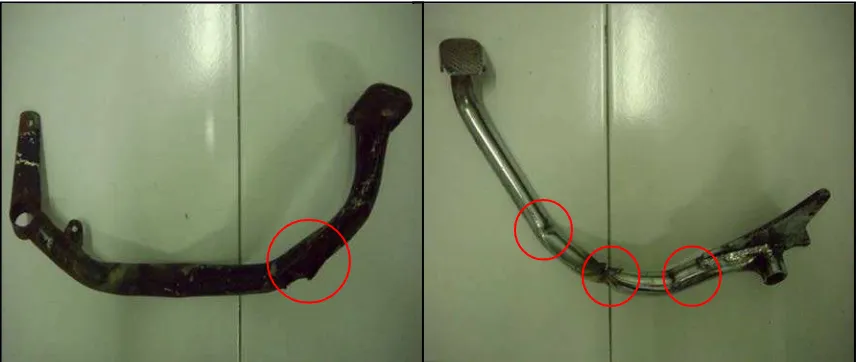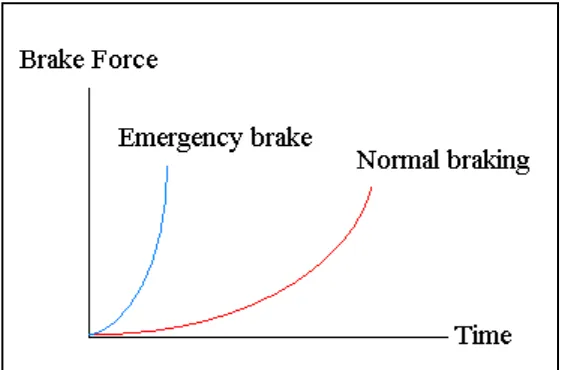THE ANALYSIS OF THE FORCES THAT ACT ON THE
MOTORCYCLE BRAKE PEDAL DURING
EMERGENCY BRAKE
SUTHAN A/L ERIN
SUTHAN A/L ERIN
This thesis is submitted in partial fulfillment of the requirement for the Bachelor of Mechanical Engineering (Automotive)
Faculty of Mechanical Engineering Universiti Teknikal Malaysia Melaka
I/We admit that have read this report and in my/our opinion this report is enough in term of scope and quality to bestowal Bachelor of Mechanical Engineering (Automotive)
Signature :……… 1st Supervisor’s name:……… Date :………
“I declare that this report is my own work except for any summary or quotation from every single source is explained”
iii
ACKNOWLEDGEMENT
I’m grateful that by the power of God, I managed to complete this project that is part of the course requirement in Faculty of Mechanical Engineering, Universiti Teknikal Malaysia Melaka (UTeM). Specifically gratitude goes to my parents, who taught me value of hard work by their own example and for their endless support in order to complete this project successfully. Both of them are my source of my inspiration that lead me to working hard in gaining knowledge. I also would like to share this moment of happiness with my brothers and sisters.
I am deeply indebted to my supervisor Mr. Nurfaizey from Mechanical Engineering Faculty, UTeM whose help, stimulating suggestions and encouragement helped me in all the time of research for and writing of this thesis. A wish to express my sincere thank to him for the enormous support during the whole project. The encouragement and motivation that was given to me to carry out my project work greatly appreciated.
The co-operation given by the laboratory management especially the technicians that involve in helping the completion of my project are appreciated.
v
ABSTRACT
ABSTRAK
vii
1.2 Problem Statement 3
1.3 Objectives 4
CHAPTER TITLE PAGE
2.6 Brake Pedal Material 14
2.7 Stress 15
2.8 Force on the Brake Pedal 16
2.9 3D Scanner 16
2.10 3-Matic Software 19 2.11 Finite Element Method 20
CHAPTER 3 METHODOLOGY 24
3.1 Introduction 24
ix
CHAPTER TITLE PAGE
CHAPTER 4 RESULT AND DISCUSSION 32
4.1 FEA Result 32
4.2 Suggestion Improvement on 37 the Existing Brake Pedal
4.2.1 Change the Brake Pipe Shape 39 4.2.2 Apply the Radius to Collar Pivot 40
LIST OF TABLES
NO. TITLE PAGE
2.1 Mechanical Properties of Low alloy steel, 15 AISI 3140 (annealed)
3.1 Patran input data 30
xi
LIST OF FIGURES
NO. TITLE PAGE
1.1 Motorcycle front and rear brake; 2 foot pedal controlling the rear brake
(Source: Basic Rider Course)
1.2 Failure at motorcycle brake pedal 3
2.1 The motorcycle in normal braking and 7 emergency brake (Source: Hudha, K (2009))
2.2 Motorcycle in emergency situation 8
2.3 Functions of brake pedal in motorcycle 9 (Source: Phongphay, T. et. al. (2006))
2.4 AX100 Brake pedal 10
2.5 CG125 Brake pedal 10
2.6 SLGS125 Brake pedal 11
NO. TITLE PAGE
2.12 Example of finite element on structure 22 (Rivai, A. (2007))
3.1 Project Flow Chart 25
3.2 The brake pedal was scanned using 26 3D Scanner in AMC laboratory
3.3 The scanned part repaired in 3-Matic software 27
3.4 The measurement from 3-Matic and drawing 28 of brake pedal using CATIA
3.5 Brake Pedal Working Principle 29
4.1 The load and boundary condition in FEA 33
xiii
4.6 The FEA result for deformation of brake pedal 37
4.7 The pipe brake was change to rectangle shape 39
4.8 The FEA result for stress of brake pedal with 39 rectangle pipe
4.9 The improvement on brake pedal 40
LIST OF APPENDIX
NO. TITLE PAGE
A Low alloy steel, AISI 3140 (annealed) 51
B Scan the brake pedal 54
C The brake pedal dimension 57
1
CHAPTER I
INTRODUCTION
This chapter will provide the information about this project. The function of the brake pedal in a motorcycle will be presented in this chapter. The problem statement, objective and scope of this project will also be included.
1.1 Background
brake pedal which is connected to the brake system in the vehicle’s movement equipment.
The basic function of brake system are to slow the speed of the vehicle, to maintain its speed during downhill operation, and to hold the vehicle stationary after it have come to a complete stop. Because of those factors, the braking system is considered by many people the most important system involved in the operation of a vehicle. The disk brake or drum brake systems will then work automatically when we push the brake pedal. This will slow and eventually stop the movements of the vehicle. Many of research and improvement are make to provide the best among the better of braking system. The ideal braking system is one system that will allow driver to stop their vehicle in the shortest possible distance. The vast majority of motorcycles use an independent brake system for the front and rear wheels, with a lever on the right handlebar controlling the front brake and foot pedal controlling the rear brake. Figure 1.1 shows the foot pedal controlling the rear brake.
3
1.2 Problem Statement
When motorcycle riders brake with the shortest possible braking distance, normally riders will start by using the rear brake. The riders only use the rear brake to start a process of shifting weight from the rear to the front wheel. During emergency brake, force that acts on the rear brake pedal is maximum. In this situation, the force should be reacted by the pedal to avoid failure. Due to the lack of information on motorcycle brake pedal structure, designers are less able to improve the existing brake pedal construction. The effect of the force on the pedal structure during emergency brake is analyzed using Finite Element Method. The analysis is focus on the design and shape of the brake pipe. The force from rider’s foot during pressing rear brake pedal was studied. Figure 1.2 shows the various types of the failure of brake pedal. The failures usually occur at the pipe brake. The study must prove that existing pedal designs are strong and safe to use at motorcycle.
1.3 Objectives
The objective of this project is to analyze forces that act on the brake pedal during emergency brake using Finite Element Method software. By understanding the stress and deformation of force on the structure of the brake pedal, this will become helpful information for designers to improve existing brake pedal construction in order to avoid brake pedal failure.
1.4 Scopes
In order to analyze the motorcycle brake pedal, scopes are required to assist and guide development of the project. The scope should be identified and planned to achieve the objective of the project successfully on the time. The scopes for this project are:
1. To create the existing brake pedal:
i. Measure the existing Honda EX5-Class motorcycle brake pedal using 3D scanner for accurate dimensions
ii. Create the existing brake pedal using CATIA V5R16 to get the complete design
5
i. The design of pedal is then exported to MCS Patran&Nastran
ii. Carry out analysis on the forces the acts on the brake pedal using Finite Element Method.
iii. Determine the critical area at brake pedal when maximum force applied
CHAPTER II
LITERATURE REVIEW
2.1 Introduction
Literature review is the study that is being done to previous research that relates to the topic. This chapter shows a concise summary of the journal or report and the methods that had been used and the results obtained.
2.2 Overview
7
previous brake pedal design must be study so that the suitable design, which fulfills the criteria and requirement of the test configuration, can be created. The basic function of brake system is to slow the speed of the vehicle. High speeds of motorcycle with a man rider influence the force on brake pedal during emergency brake. There is very limited time and obvious distractions when a motorcyclist is in an emergency braking situation. During the time that the rider is thinking about applying the brakes and moving foot to brake pedal, the vehicle will travel a certain distance depending on the speed of vehicle. After the brakes are applied, the vehicle will travel on additional distance before it is brought to a stop. Total stopping distance of a vehicle is the total of the distance covered during the rider reaction time and the distance during which the brakes are applied before the vehicle stops.
Figure 2.1: The motorcycle in normal braking and emergency brake (Source: Hudha, K (2009))
will cause the brake pedal damage or bend. Finite element method is use to study the stress on the pedal structure while riders apply force during emergency brake.
Figure 2.2: Motorcycle in emergency situation
Brake pedal for the automobile industry are made by press forming of steel strips formed to adequate shapes and dimensions. In order to prevent future failure during manufacturing processes, the origin of the cracking pedal problem was investigated. For the mechanical characterization of the material, hardness, tensile and bending tests have been carried out and the analysis was complement with detailed micro structural observations.



